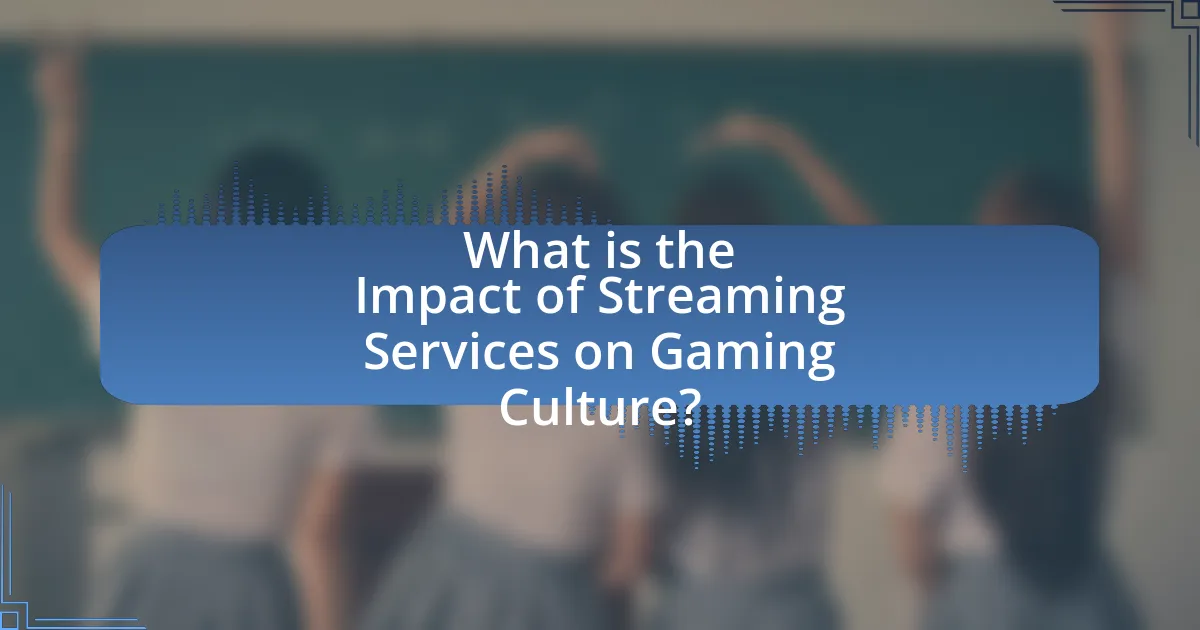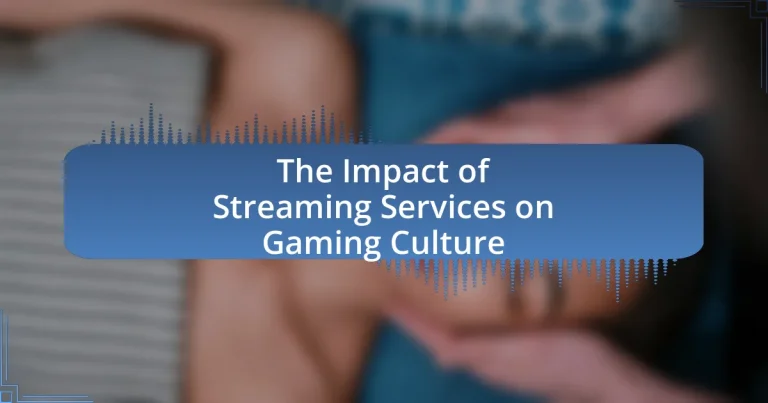The article examines the significant impact of streaming services on gaming culture, highlighting how platforms like Twitch and YouTube Gaming enhance community engagement and accessibility. It discusses the transformation of game consumption through subscription models, the role of streamers in influencing game popularity and sales, and the social implications of real-time interaction among gamers. Additionally, the article explores how streaming services have broadened player demographics, influenced game development and marketing strategies, and the challenges they pose to traditional gaming culture. It also addresses the potential downsides of streaming culture for gamers and offers strategies for balancing streaming consumption with personal gaming experiences.

What is the Impact of Streaming Services on Gaming Culture?
Streaming services significantly influence gaming culture by enhancing community engagement and accessibility. Platforms like Twitch and YouTube Gaming allow gamers to share experiences, showcase gameplay, and interact with audiences in real-time, fostering a sense of community. According to a 2021 report by Streamlabs, Twitch alone had over 9.5 million unique streamers, indicating a growing trend in content creation around gaming. This shift has led to increased visibility for games, driving sales and player interest, as seen with titles like “Among Us,” which surged in popularity due to streaming exposure. Furthermore, streaming services have democratized content creation, allowing diverse voices to emerge in the gaming space, thus reshaping the cultural landscape of gaming.
How have streaming services changed the way games are consumed?
Streaming services have fundamentally transformed game consumption by enabling instant access to a vast library of games without the need for physical ownership. This shift allows players to explore diverse titles through subscription models, such as Xbox Game Pass and PlayStation Now, which offer hundreds of games for a monthly fee. According to a report by Newzoo, the global gaming market reached $159.3 billion in 2020, with a significant portion attributed to the rise of streaming services, indicating a growing trend towards digital consumption. Additionally, platforms like Twitch and YouTube Gaming have popularized game streaming, allowing players to engage with content creators and communities, further influencing gaming habits and preferences.
What role do platforms like Twitch and YouTube play in gaming culture?
Platforms like Twitch and YouTube serve as pivotal hubs for gaming culture by facilitating content creation, community engagement, and live interaction among gamers. These platforms enable gamers to share gameplay experiences, tutorials, and commentary, which fosters a sense of community and belonging. For instance, Twitch reported over 140 million unique monthly viewers in 2020, highlighting its significant role in connecting gamers and audiences. Additionally, YouTube’s gaming content garnered over 100 billion views in 2018 alone, demonstrating its influence in shaping gaming trends and culture. Through these platforms, gamers can not only consume content but also participate in discussions, stream their own gameplay, and engage with their favorite creators, thereby enriching the overall gaming experience.
How has the accessibility of games through streaming influenced player demographics?
The accessibility of games through streaming has significantly broadened player demographics by allowing diverse audiences to engage with gaming without the need for expensive hardware. Streaming platforms like Twitch and YouTube Gaming have made it possible for individuals to play and experience games on various devices, including smartphones and tablets, which has attracted a wider age range and more casual gamers. According to a report by Newzoo, the global gaming audience reached 3 billion in 2021, with a notable increase in players aged 35 and older, indicating that streaming has successfully drawn in older demographics who may not have previously engaged with gaming. Additionally, the rise of cloud gaming services, such as Google Stadia and NVIDIA GeForce Now, has further democratized access, enabling players from different socioeconomic backgrounds to participate in gaming culture.
What are the social implications of streaming services in gaming?
Streaming services in gaming significantly enhance social interaction among players and audiences. These platforms facilitate real-time engagement, allowing gamers to connect through live streams, chat features, and community forums. For instance, Twitch reported over 140 million monthly active users in 2021, showcasing the platform’s role in fostering a sense of community among gamers. Additionally, streaming services democratize content creation, enabling diverse voices to share their gaming experiences, which can lead to increased representation and inclusivity within the gaming culture. This shift has also influenced social dynamics, as viewers often form relationships with streamers, creating a new form of social capital and community identity.
How do streaming services foster community engagement among gamers?
Streaming services foster community engagement among gamers by providing interactive platforms that facilitate real-time communication and collaboration. These platforms, such as Twitch and YouTube Gaming, enable gamers to connect through live chats, allowing viewers to interact with streamers and each other during gameplay. This interaction creates a sense of belonging and community, as evidenced by Twitch’s statistics showing that over 15 million daily active users engage in chat during streams, fostering relationships and shared experiences among gamers. Additionally, features like community events, tournaments, and collaborative gameplay further enhance engagement, as they encourage participation and teamwork, solidifying the community aspect within the gaming culture.
What impact do streamers have on game popularity and sales?
Streamers significantly enhance game popularity and sales by providing exposure and engagement to a wide audience. When popular streamers showcase a game, they can attract thousands to millions of viewers, leading to increased interest and subsequent purchases. For instance, a study by Newzoo found that 70% of gamers are influenced by streamers when deciding which games to buy. Additionally, games like “Among Us” and “Fall Guys” saw substantial sales spikes following their viral moments on platforms like Twitch and YouTube, demonstrating the direct correlation between streamer visibility and game sales.
How do streaming services affect game development and marketing?
Streaming services significantly influence game development and marketing by providing a platform for exposure and community engagement. Developers increasingly design games with streaming in mind, incorporating features that enhance viewer interaction, such as spectator modes and shareable content. This shift is evidenced by the rise of games like “Among Us” and “Fall Guys,” which gained popularity through streamers showcasing them on platforms like Twitch and YouTube.
Moreover, marketing strategies have evolved to leverage these platforms, with developers using influencer partnerships to reach wider audiences. For instance, a report by Newzoo indicates that 70% of gamers are influenced by streamers when making purchasing decisions. This data underscores the importance of streaming services in shaping consumer behavior and driving sales in the gaming industry.
What trends in game design have emerged due to streaming culture?
Streaming culture has led to several significant trends in game design, primarily focusing on interactivity, community engagement, and monetization strategies. Game developers are increasingly incorporating features that enhance viewer interaction, such as live voting on game decisions or real-time challenges, which cater to the audience’s desire for participation. Additionally, games are being designed with social features that encourage community building, such as integrated chat systems and cooperative gameplay, reflecting the communal aspect of streaming platforms. Monetization strategies have also evolved, with many games adopting free-to-play models supported by microtransactions, which align with the revenue models of popular streaming services. These trends are evident in titles like “Fortnite” and “Among Us,” which have successfully leveraged streaming culture to boost player engagement and visibility.
How do developers leverage streaming platforms for marketing their games?
Developers leverage streaming platforms for marketing their games by collaborating with popular streamers to showcase gameplay, which increases visibility and engagement. This strategy capitalizes on the large audiences that streamers attract, allowing developers to reach potential players directly. For instance, a study by Newzoo found that 70% of gamers are influenced by streamers when deciding on a game to purchase. Additionally, developers often host live events or exclusive content reveals on platforms like Twitch and YouTube, creating buzz and anticipation around their games. This approach not only enhances community interaction but also drives sales through immediate viewer engagement.
What challenges do streaming services pose to traditional gaming culture?
Streaming services challenge traditional gaming culture by shifting focus from gameplay to content consumption. This transition can diminish the social and interactive aspects of gaming, as players may prioritize watching streams over participating in games themselves. For instance, platforms like Twitch and YouTube Gaming have seen exponential growth, with Twitch reporting over 140 million unique monthly viewers in 2021, indicating a significant audience shift. This trend can lead to a decline in community engagement within traditional gaming, as players may feel less inclined to connect with others through direct gameplay experiences.
How do streaming services impact the perception of gaming as a profession?
Streaming services significantly enhance the perception of gaming as a legitimate profession by providing visibility and monetization opportunities for gamers. Platforms like Twitch and YouTube Gaming allow gamers to showcase their skills, build audiences, and earn income through subscriptions, donations, and sponsorships. According to a report by Newzoo, the global esports market is projected to exceed $1.5 billion by 2023, indicating a growing recognition of gaming as a viable career path. This visibility not only attracts aspiring gamers but also fosters a cultural shift, where gaming is increasingly viewed as a professional endeavor rather than a mere hobby.
What are the potential downsides of streaming culture for gamers?
The potential downsides of streaming culture for gamers include increased pressure to perform, diminished gaming experiences, and potential mental health issues. Gamers often feel compelled to maintain a constant online presence and deliver high-quality content, which can lead to burnout and stress. Additionally, the focus on entertainment value can overshadow the intrinsic enjoyment of gaming, causing players to prioritize viewer engagement over personal satisfaction. Research indicates that excessive exposure to online platforms can contribute to anxiety and depression among gamers, highlighting the mental health risks associated with streaming culture.
How can gamers adapt to the evolving landscape of streaming services?
Gamers can adapt to the evolving landscape of streaming services by embracing new platforms and technologies that enhance their gaming experience. As streaming services like Twitch and YouTube Gaming grow, gamers should engage with these platforms to build communities, share gameplay, and learn from others. For instance, according to a report by Newzoo, over 1.1 billion people watch gaming content online, indicating a significant audience that gamers can tap into for networking and exposure. Additionally, gamers can utilize tools such as cloud gaming services, which allow them to play high-quality games on various devices without the need for expensive hardware. This adaptability not only keeps gamers relevant in a rapidly changing environment but also opens up new opportunities for monetization and collaboration within the gaming community.
What strategies can gamers use to engage with streaming content effectively?
Gamers can engage with streaming content effectively by actively participating in chat interactions, following streamers on multiple platforms, and sharing content on social media. Active participation in chat allows gamers to ask questions and provide feedback, fostering a sense of community and connection with the streamer. Following streamers on platforms like Twitch, YouTube, and social media enhances engagement by keeping gamers updated on content and events. Sharing content on social media platforms increases visibility and encourages discussions among peers, further enriching the gaming experience. These strategies are supported by studies showing that community interaction significantly enhances viewer retention and satisfaction in streaming environments.
How can gamers balance streaming consumption with their own gaming experiences?
Gamers can balance streaming consumption with their own gaming experiences by setting specific time limits for watching streams and prioritizing their gaming sessions. By allocating dedicated hours for both activities, gamers can ensure they enjoy the content from streamers while also engaging in their own gameplay. Research indicates that time management strategies, such as the Pomodoro Technique, can enhance focus and productivity, allowing gamers to enjoy streaming without sacrificing their gaming time. This structured approach helps maintain a healthy balance, ensuring that streaming enhances rather than detracts from personal gaming experiences.


